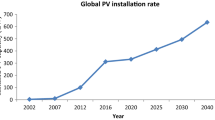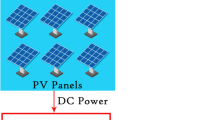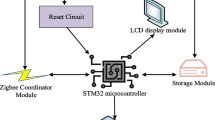Abstract
A thermoelectric module was modeled and analyzed in COMSOL Multiphysics using a finite element method (FEM). An optimum coefficient of performance of 0.4 is achieved at an operational current of 2 A, and a maximum heat load of 0.52 W is obtained at zero temperature gradient. The system’s dynamic cooling behavior was simulated and the input and output data were exported to the system identification toolbox in MATLAB for the prediction of the mathematical model. The predicted model was validated and a suitable proportional integral (PI) controller was designed for the system. However, the controller needs to be optimized. Optimization techniques namely: Grey Wolf Optimizer (GWO), Particle Swarm Optimization (PSO), Artificial Bee Colony (ABC), and Harris Hawk Optimization (HHO) were tested on the controller. GWO having a settling time of 199 seconds and an overshoot of 5.96% is found to be the best for this model.






Similar content being viewed by others
Abbreviations
- α :
-
Seebeck coefficient
- T c :
-
Cold side temperature
- T h :
-
Hot side temperature
- R :
-
TEC internal resistance
- K :
-
Thermal conductivity
- ρ :
-
Resistivity
- I :
-
TEC input current
- COP:
-
Coefficient of performance
- Q c :
-
Heat absorbed on the cold side
- Q h :
-
Heat released on the hot side
- Q L :
-
Heat load
- P ele :
-
Input electrical energy
- ∆T :
-
Temperature gradient
References
Riffat S B and Ma X 2003 Thermoelectrics: a review of present and potential applications. Appl. Therm. Eng. 23: 913–935
Chein R and Huang G 2004 Thermoelectric cooler application in electronic cooling. Appl. Therm. Eng. 24: 2207–2217
Wang X-D, Huang Y-X, Cheng C-H, Ta-Wei Lin D and Kang C-H 2012 A three-dimensional numerical modeling of thermoelectric device with consideration of coupling of temperature field and electric potential field. Energy 47: 488–497
Phelan P E, Chiriac V A and Lee T-YT 2002 Current and future miniature refrigeration cooling technologies for high power microelectronics. IEEE Trans. Comp. Packag. Technol. 25: 356–365
Zhou Y and Yu J 2012 Design optimization of thermoelectric cooling systems for applications in electronic devices. Int. J. Refrig. 35: 1139–1144
Cheng Y-H and Lin W-K 2005 Geometric optimization of thermoelectric coolers in a confined volume using genetic algorithms. Appl. Therm. Eng. 25: 2983–2997
Zhu L, Tan H and Yu J 2013 Analysis on optimal heat exchanger size of thermoelectric cooler for electronic cooling applications. Energy Convers. Manag. 76: 685–690
Sundayani, Sinulingga D F, Prasetyawati F M, Palebangan F M, Suhendi A, Ajiwiguna T A, Handayani I P and Fathonah I W 2017 PID temperature controlling of thermoelectric based cool box. In: Proceedings of the International Conference on Control, Electronics, Renewable Energy and Communications (ICCREC), Yogyakarta: IEEE, pp. 236–240
Shaojing S and Qinqin 2010 Temperature control of thermoelectric cooler based on adaptive NN-PID. In: Proceedings of the International Conference on Electrical and Control Engineering, pp. 2245–2248
Selvi V and Umarani Dr R 2010 Comparative analysis of ant colony and particle swarm optimization techniques. Int. J. Comput. Appl. 5: 1–6
Mirjalili S, Mirjalili S M and Lewis A 2013 Grey wolf optimizer. Adv. Eng. Softw. 69: 46–61
Heidari A A, Mirjalili S, Faris H, Aljarah I, Mafarja M and Chen H 2019 Harris hawks optimization: algorithm and applications. Future Gener. Comput. Syst. 97: 849–872
Sharma S and Bhambu P 2016 Artificial bee colony algorithm: a survey. Int. J. Comput. Appl. 149: 11–19
Acknowledgements
This work was supported by the Scientific and Technological Research Council of Turkey (TUBITAK) [grant numbers 216M252, 216M254, FDP-2019-33416]; Scientific Coordination Unit of Istanbul University [grant numbers 32641, 35577].
Author information
Authors and Affiliations
Corresponding author
Rights and permissions
About this article
Cite this article
Yusuf, A., Koç, T., Arikuşu, Y.S. et al. Modeling of a thermoelectric cooler system, design and optimization of the system’s controller. Sādhanā 47, 182 (2022). https://doi.org/10.1007/s12046-022-01954-8
Received:
Revised:
Accepted:
Published:
DOI: https://doi.org/10.1007/s12046-022-01954-8




